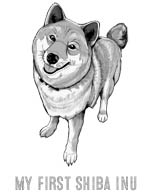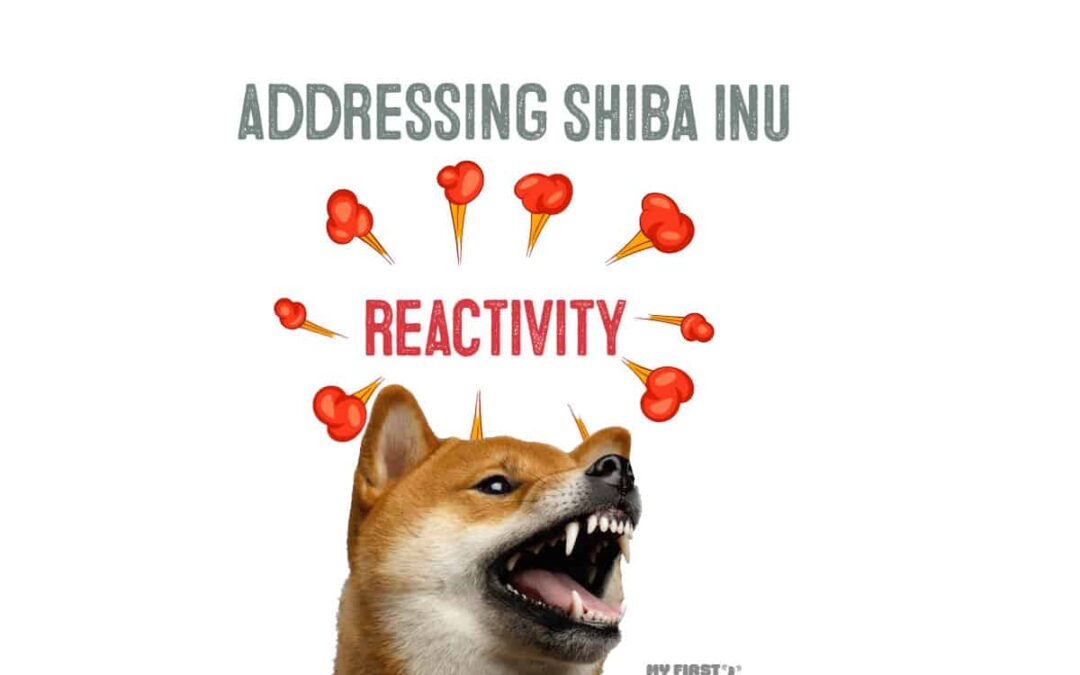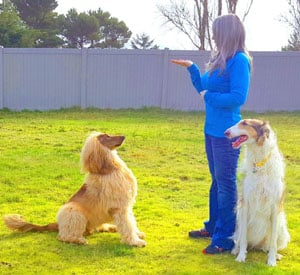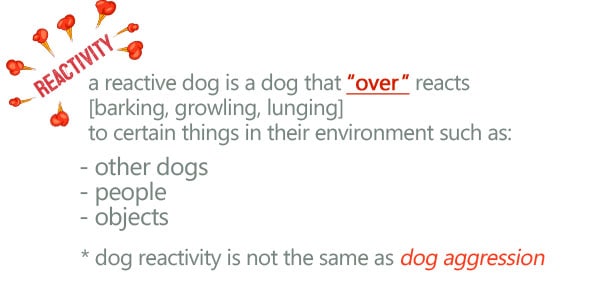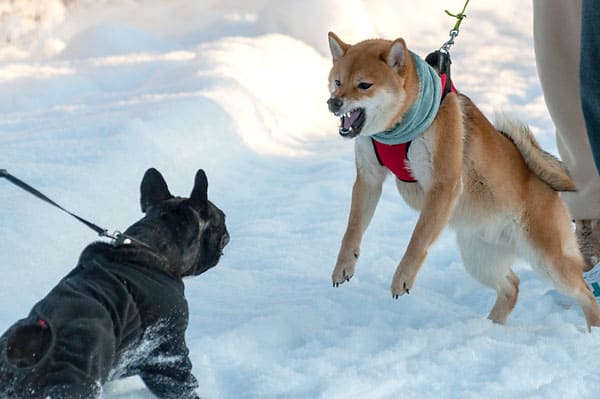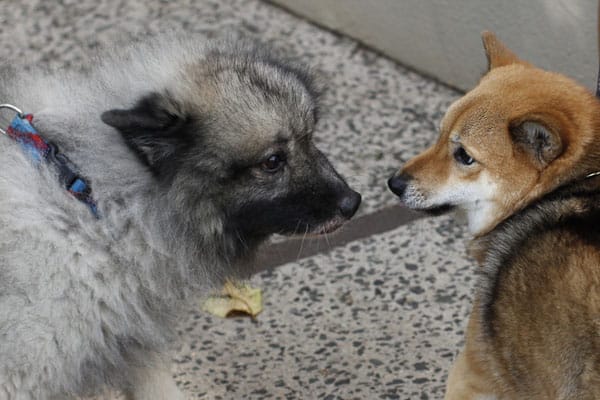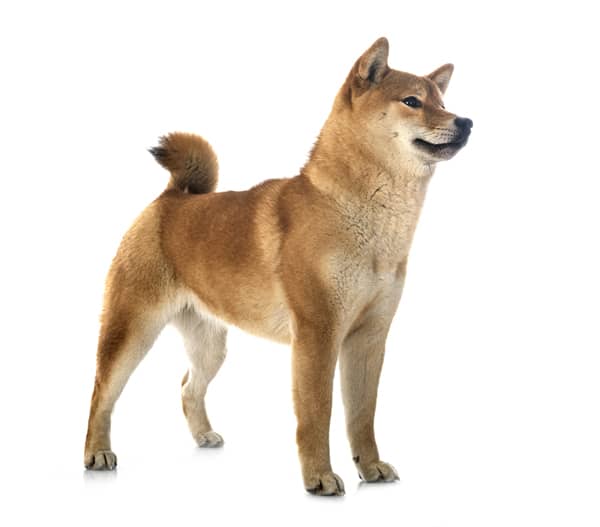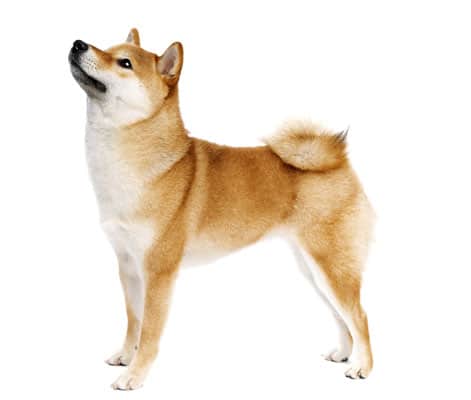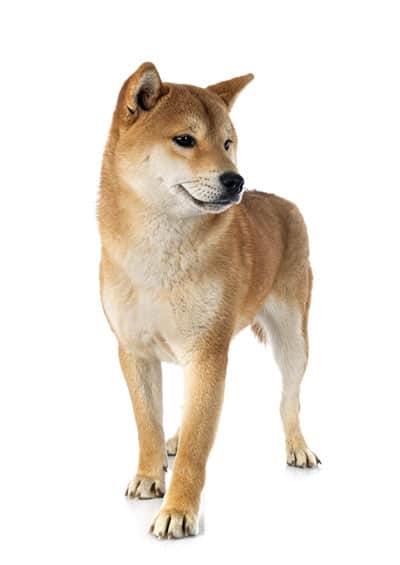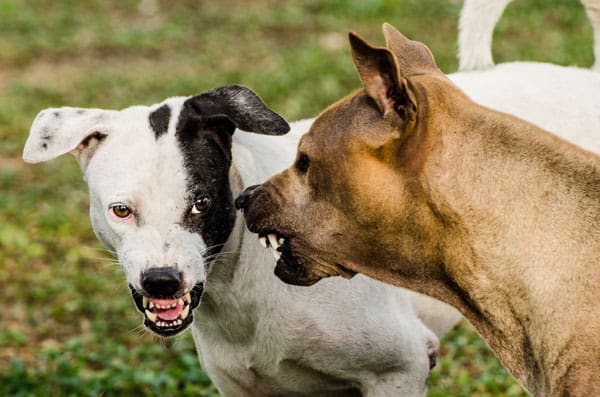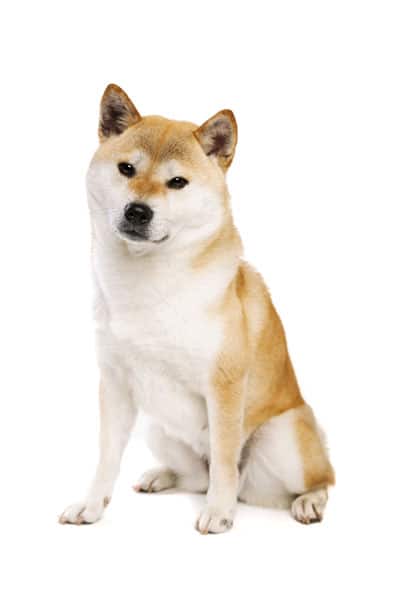Last Modified: 11/16/2023
On occasion, our posts contain affiliate links. However, we only recommend products that we truly believe in. For more information, visit my privacy policy page.
Rain Jordan, CBCC-KA, CPDT-KA, KPA CTP, Fearful Dogs Expert www.ExpertCanine.com |www.CanineFearSolutions.com | www.FearfulDogsProject.org
What is a “Reactive” Behavior in a Shiba?
Simply put, we might think of reactivity as behavior in which an organism’s responses to stimuli are more emotionally charged than intellectually informed.
People who outrageously speak before they think might be labeled reactive—those who yell first and asks questions later, for example.
For non-human animals like dogs, oftentimes the reactivity appears explosive— the dog version of our yelling, cussing, stomping, et cetera.
Many dogs bark immediately at certain stimuli.
Some also lunge or perform other behavior we humans might decide is based in overexcitement, agitation, or frustration.
What earns the behavior the “reactivity” label is that the reaction is out of proportion to the stimulus and the reactive behavior appears as if out of control.
While we probably wouldn’t consider a dog who becomes excited when her human comes home reactive, we might consider reactive a stranger-averse dog who becomes overaroused and hypervocal when her human comes home, bringing a new friend with her.
Dogs are individuals and might react to any number of arousing stimuli – leashes, fences, windows, and car doors (dog inside car) are among the most common stimuli that lead to agitation in some dogs.
When conditions prevent these dogs from behaving to achieve whatever might be their goal—e.g., meet the dog on the other side of the fence, chase the dog running off leash, scare away the puffy-coated stranger walking by the car, et cetera— frustration sometimes turns physical.
B. F. Skinner at least once presented unresolved frustration as a potential source of rage.
Though there are others, the most common physical expressions of frustration-based reactivity include barking, lunging, clawing, jumping, running (fence lines, for example), and so on.
Once in a while, especially if these or other physical expressions of frustration are further thwarted, whether by attempts to restrain, or human-delivered corrections, or otherwise, we might see escalation to a bite.
While there is no really good way to confirm an animal’s intent, sometimes reactivity escalated to a bite may be the result of thrashing; other times it may be what we call “redirection,” the result of someone having interfered physically.
Some behavior professionals might consider additional behaviors, like compulsive behavior, reactivity-indicative, though it just as likely could not be, and some might consider an array of behaviors generally associated with being overstressed or ‘over threshold’ as indicative as well.
However, since clear delineation is important for the struggling dog owner, it’s probably best to categorize “reactivity” as separate and distinct from “stressed” or “over threshold.”
Sometimes, reactivity might be the long-term result of a dog’s learning history.
A small dog who was once bitten by a large dog during a leash walk learned from that incident that at least sometimes, that combination of stimuli is harmful.
It’s possible that from that point on, such a dog will therefore ‘react’ to large dogs during leash walks.
Similarly, a dog who has learned previously that having a collar put on is followed by a shock from said collar may in the future become reactive when any collar is presented, or when it is presented under certain conditions similar to the shock collar event.
Once in a while, people don’t notice any trigger for their dog’s reactivity.
Part of solving that puzzle involves learning more about dog body language and social dynamics, then observing more closely.
One dog giving your dog a hard stare as you pass could be enough to cause your dog to react.
A certain smell, like a perfume brand or a barbeque, might trigger reaction if it is associated with something upsetting in your dog’s history.
There are some breeds for whom “reactive” type displays indicate little more than breeding that has upheld artificial selection—what the breed was originally used by humans for—or breeding combined with lack of owner preparedness for same.
If a rat terrier loses her mind at even the slightest movement in the lawn, shrubs, or garage, we might pause and ask ourselves why she’s called a “rat terrier”; her breed group’s nature is to rid its area of certain small creatures.
For such breeds, this kind of reaction may be normal, not abnormal.
A “reactive” dog may or may not become “aggressive,” and the two may or may not be related.
Given the importance of defining one’s terms, I’ll define “aggression” asbehavior directed toward eliminating competition by injuring or killing the competitor.
From this perspective, reactivity and aggression are different.
Even in cases where reactivity escalates to a bite injury, we could argue that the behavior was not directed toward eliminating competition.
Of course my definition of aggression isn’t the only one, but it’s the one I find most clear and helpful in assessing and treating behavior cases.
Can Reactive Shiba Inu Behavior Be Cured?
In the animal behavior profession, ethics require that we refrain from promising cures.
This is largely because animals are sentient individuals with varying needs, motivations, and other traits that are always susceptible to change.
Therefore, we cannot control their behavior absolutely, and certainly not inhumanely.
We provide interventions based, for example, in classical and operant conditioning to modify reactivity such that it may be largely reduced in some, most, or all contexts, but we cannot guarantee 100% permanence or perfection.
Achieving long-term recovery is largely a matter of maintaining what was achieved by continued practice and positive reinforcement for the improved behavior, and in various contexts including currently non-triggering ones.
This helps avoid the behavior jumping to another stimulus.
Can Reactivity Be Prevented?
Once again there is no way to absolutely guarantee a dog behavior, nor a lack of a particular behavior.
However, just as behavior modification can reduce reactivity, proper preparation helps set up your dog for success:
Proper young puppy socialization (generally before 12-14 weeks of age), followed by positive training, continued positive conditioning, and environmental control to reduce risk of situations that result in your dog developing negative associations with stimuli.
On the flip side, aversive experiences may tend to increase the risk of future reactivity, as well as of fear and other concerns.
A dog who wasn’t socialized properly as a young puppy is more likely to develop behavior issues than a dog who did receive proper socialization as a puppy.
A puppy or dog who was mishandled, punished, scared, or exposed improperly to new or concerning stimuli may become reactive in similar contexts.
Treating Shiba Inu Reactive Behavior Issues
Often, people misinterpret recommendations of “management” to mean it’s all that is needed to resolve a behavior problem.
Management is not a solution so much as it is one of several additional support options dog owners may decide to implement, especially during the behavior modification process.
Management is, essentially, avoiding situations where the undesired behavior might occur.
However, if reactivity is a result of learning history, it’s best to also implement a positive behavior modification program to help the dog relearn more positive associations.
This more complete process may also be more humane in that by changing associations, we assume feelings are changed as well. We all want our dogs to feel good, not bad.
Generally, we look at the options for behavior resolution starting with the most humane, least stressful option for the dog.
The order is typically:
1) Health
2) Antecedent Arrangement (sometimes also considered management though this isn’t always the same thing), and
3) Training & Behavior Modification Protocols
1) Health
1) A dog who suddenly and without any identifiable trigger becomes reactive or develops other behavior issues might be ill or in pain; physical discomfort is a common reason that a dog might suddenly change behavior.
Such discomfort may also be the root of some behavior changes that occur over time, such as what can happen during the progression of canine cognitive dysfunction syndrome.
2) Antecedent Arrangement
2) If your dog has been recently vetted and found healthy, and no injurious incidents have occurred since then, unless a second opinion seems in order, begin with antecedent &/or consequence rearrangement.
An antecedent is something that comes just before the target behavior occurs and is related to the behavior.
For example, if every time someone in your home slams a door, your dog immediately goes on a barking spree, the antecedent to the barking spree is probably the door slam.
If you make a new house rule that no door shall be slammed for any reason, and your dog was indeed reacting to the slam, then your dog’s barking spree, at least in that context, may be resolved by changing the antecedent.
No slam, no barking spree.
For our purposes here, an antecedent is someone or something that appears or occurs in the environment, just before the dog performs the undesired behavior.
Therefore, think of antecedent rearrangement as a sort of behavior modification for the dog’s humans.
It’s not just our dogs that need their behavior modified in order for us to have a happier life together!
If your response to the door-slam-inspired barking spree has previously been to go over and pick up your dog, and your dog enjoys being picked up, then your doing so is a consequence to barking that may also be contributing to the continued barking sprees.
In this example, however, you would not just stop picking up your dog—one, because the dog would still be suffering the distress of the door slam and resultant barking spree, and two, because it’s good to help your dog feel better when scared or distressed.
Instead, simply changing the antecedent can reduce the undesired behavior and the distress. (In a different type of case, say your dog begins barking before every meal time, you might decide to change both antecedent and consequence, since this barking is probably what is commonly called ‘demand’ barking, not barking out of fear or distress.
If you already know what the antecedent is and it is something within your ability to change, you may be able handle the situation yourself, without professional assistance.
3) Training & Behavior Modification Protocols
3) If antecedent changes do not help or are not possible, then your next option is positive training and behavior modification.
For this it is important to work directly with a credentialed, anti-aversives training and behavior professional such as a certified behavior consultant, typically a CBCC-KA or CDBC.
Remember to confirm anti-aversives policy and practice with your candidate before hiring her.
If your dog’s reactivity poses a possible safety risk to you or anyone else, human or non-human, it’s imperative that you hire such a professional.
Being pulled down a hill by your leashed dog, having a finger broken by a suddenly taut leash, or having someone else be hurt, leading to a lawsuit, would be more expensive to you than hiring an anti-aversives professional.
Behavior modification will involve operant training and desensitization with operant counterconditioning and/or classical counterconditioning.
One operant procedure that can provide great classical counterconditioning effects at the same time is a procedure in which the person handling the dog marks and reinforces (with high value food items) the dog for simply noticing a trigger without “reacting.”
Over time this can help the reactive dog by teaching her that the trigger predicts something yummy; in other words, it changes the association she has with the currently triggering stimuli.
Again, please do not attempt this without first having a professional teach you the details in person.
In order to begin the process, your behavior consultant will teach you how to practice in non-triggering situations and very small increments of progress over time.
She also will help you develop a solid understanding of canine body language as well as keen observation skills, proper handling skills, and proper timing.
For most people, this is too much to attempt without professional guidance.
Ask your behavior consultant to explain the necessary skills and procedures to you and to perform the procedure while you observe, at least at first.
Then you can decide when you are ready to have her observe and coach you while you implement the procedure, and then together you can decide when you are ready to continue on without her.
Although for a few people it might be better to have your behavior consultant handle the procedure completely on her own, generally this is not recommended because you will need to become proficient in this and other skills in order to maintain progress and to be able to apply the procedures to any future issues that arise.
There are various other counterconditioning and training methods that can help but it’s important to be sure you obtain complete, careful instruction from a professional before you attempt these, because even something as simple as when to reach for the treat can affect your results.
You will notice that nowhere in this article are recommendations for corrections, punishments, or negative reinforcement; that’s because all of those things would add to the negative associations your dog already carries regarding a trigger, or, if your dog is simply one of those selected for the target behavior, you might inadvertently create a new negative association.
For more information on this, please read the article on aversives.
While you are seeking out your preferred behavior consultant, avoiding triggers and potential situations where triggers might appear is crucial.
If your dog barks at visual stimuli from your windows, you might install temporary (or permanent) window film.
If your dog reacts to non-resident humans entering your home, put off visits. If your dog is reactive to traffic or crowds, you might choose to only walk in areas not much traversed.
Since many dogs experience reactivity when on a leash, consider also changing from a collar to a non-tightening body harness, since being pulled by the collar is a common stressor for dogs, not to mention a physical danger to the dog.
Remember, management is only a beginning, and while there are many options for management that can help by giving you time to proceed to an appropriate behavior program, that program will be the key to success.
Rain Jordan is a Certified Behavior Consultant, Canine (CBCC-KA), a Fearful Dogs Expert, a CPDT-KA, a Certified Training Partner – Karen Pryor Academy for Animal Training & Behavior (KA CTP), and the author of several books about dogs, rescue, dog behavior, and animal welfare. Learn more at www.ExpertCanine.com, www.CanineFearSolutions.com and www.FearfulDogsProject.org
Thanks for visiting Myfirstshiba.com! We do our very best in providing our readers with awesome content about our beloved Shiba Inu breed. Some of our articles include reviews and recommendations to our favorite products. We do occasionally earn commissions from certain affiliate links that help support our work and mission. Thanks again for visiting. Shiba Kisses To All!
